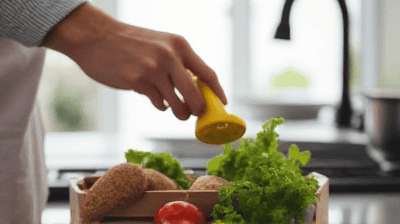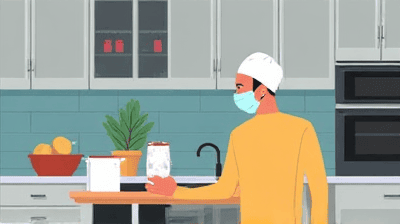Preventing Cross-Contamination: Kitchen Hygiene Essentials



In modern kitchens, the convenience of cooking should never come at the cost of safety, especially when it comes to food hygiene. Preventing cross-contact, which occurs when allergens or harmful bacteria are transferred from one food item to another, is crucial for maintaining a safe cooking environment.
Cross-contact occurs when allergens or pathogens from one food item come into contact with another food item, often through shared surfaces, utensils, or hands. This can happen in various ways, such as:
Using the Same Cutting Board: If you chop raw chicken on a cutting board and then use it for vegetables without proper cleaning, bacteria from the chicken can contaminate the vegetables.
Shared Utensils: Using the same knife to slice bread after cutting meat can transfer allergens and bacteria.
Improper Storage: Storing allergenic foods above non-allergenic foods in the refrigerator can lead to drips and contamination.
Food Allergies: For individuals with food allergies, cross-contact can lead to severe reactions, including anaphylaxis. Understanding how to prevent cross-contact is crucial for keeping these individuals safe.
Foodborne Illness: Bacteria such as Salmonella and E. coli can easily transfer from raw foods to prepared dishes, posing health risks to everyone.
Regulatory Compliance: Many food establishments are required by law to implement strict protocols to prevent cross-contact, to ensure the safety of the food they serve.
Consumer Trust: Home cooks who prioritize hygiene and safety enhance the trust of their family and friends in the food served.
Healthy Eating Environment: A focus on preventing cross-contact contributes to a cleaner and healthier kitchen overall.

To effectively prevent cross-contact, it’s essential to adhere to fundamental principles of kitchen hygiene. These practices form the backbone of any safe food preparation environment.
Regular cleaning of kitchen surfaces, utensils, and equipment is key to preventing cross-contact. Ensuring that all areas are clean helps to minimize the risk of contamination.
Daily Cleaning Routine: Establish a routine for daily cleaning of high-touch surfaces, including countertops, cutting boards, sinks, and appliances.
Sanitizers: Use appropriate sanitizers to disinfect surfaces after cleaning. Be aware of the contact time required for effective disinfection.
Keeping different food types separate during preparation can dramatically reduce the risk of cross-contact.
Separate Cutting Boards: Use designated cutting boards for different food types (e.g., one for meat, one for vegetables).
Color-Coded Utensils: Invest in different colored utensils to prevent confusion and ensure that allergenic ingredients do not come into contact with safe foods.
Storage Practices: Store allergenic foods on separate shelves in the refrigerator to avoid drips.
Hands can easily transfer allergens and bacteria from one food item to another. Regular and proper handwashing is essential in the kitchen.
When to Wash: Wash hands before preparing food, after handling raw foods, after using the restroom, and after touching any potentially contaminated surfaces.
Handwashing Technique: Use soap and warm water, scrubbing for at least 20 seconds before rinsing thoroughly.
How you cook and prepare food can also affect cross-contact risks.
Cooking Temperatures: Ensure that all foods are cooked to their appropriate internal temperatures to kill harmful bacteria.
Avoid Reusing Cooking Oils: Reusing oil from frying allergenic foods can transfer allergens to other foods.
Educating yourself and others in your household about cross-contact and kitchen hygiene is vital.
Labels and Allergens: Read labels to identify allergens in packaged foods.
Training Family Members: Teach all household members about the importance of preventing cross-contact and the methods to do so.
Having the right tools in your kitchen can facilitate better hygiene practices and prevent cross-contact. Here is a list of essential items to consider.
Investing in a set of color-coded cutting boards can help designate different boards for various food types. For example:
Using specific utensils for different food types can help avoid cross-contact.
Dedicated Knives: Have separate knives for cutting meat and vegetables.
Spatulas and Spoons: Color-coded spatulas can help maintain separation.
Proper food storage containers with tight-fitting lids minimize the risk of cross-contact when storing leftovers or prepped ingredients.
Labeling: Clearly label containers containing allergens.
Separate Shelving: Designate shelves in your refrigerator for allergenic foods.
Keep sanitizing wipes or sprays handy for quick cleaning of surfaces between food prep tasks.
Gloves and aprons can act as barriers and help prevent cross-contact, especially while handling allergenic foods.
Disposable Gloves: Use when preparing food for someone with allergies.
Aprons: Wear aprons to protect your clothes and avoid transferring allergens from clothing to food.

Implementing a systematic approach can help ensure that cross-contact is minimized during food preparation. Here’s a step-by-step guide:
Clean Surfaces: Start by cleaning your countertops, sinks, and any surfaces where you plan to prepare food.
Organize Ingredients: Gather all ingredients and separate allergenic items from those that are safe.
Set Up Workstations: Designate specific areas for preparing different types of food, especially if you are preparing allergenic and non-allergenic items simultaneously.
Select Cutting Boards: Choose the right cutting board for the task, ensuring it is clean and designated for that type of food.
Gather Utensils: Assemble the necessary utensils, ensuring they are clean and appropriate for the food types you are working with.
Check Labels: Verify any packaged foods for allergens, ensuring they are safe to use.
Wash Hands Frequently: Wash hands before starting food preparation and after handling each food type, particularly raw meats.
Prep with Care: Cut and prepare allergenic ingredients last to reduce the risk of cross-contact.
Use Separate Cookware: Cook allergenic foods in separate pans or dishes to avoid any potential transfer.
Monitor Cooking Temperatures: Use a food thermometer to ensure that all foods are cooked to the required internal temperature.
Avoid Overcrowding Pans: When cooking, prevent overcrowding to allow even cooking and avoid splattering.
Wash Utensils Immediately: Clean all tools, utensils, and cutting boards right after use to avoid drying bacteria.
Sanitize Surfaces: After cooking, sanitize all surfaces using appropriate cleaning solutions.
Store Leftovers Safely: As soon as food has cooled, store leftovers in separate, labeled containers, ensuring no allergens are mixed.
Being aware of common sources of cross-contact helps in identifying potential risks in your kitchen. Here are some common culprits:
These are often the biggest sources of harmful bacteria. Always handle them with care and ensure that their juices do not come into contact with other foods.
For individuals with lactose intolerance or dairy allergies, ensuring separation of dairy products from non-dairy foods is essential.
Common allergens like nuts and gluten can trigger severe allergic reactions. Use separate equipment and storage for these items.
While generally safe, fruits and vegetables can carry pesticides or allergens from cross-contact with allergenic foods. Always wash them thoroughly.

Educating yourself on common food allergens can help personalize your approach to preventing cross-contact. The most common allergens include:
Recognizing symptoms of food allergies can aid in swift action if accidental cross-contact occurs. Common symptoms include:
For individuals managing food allergies, maintaining an allergy-free kitchen is paramount. This might include:
Educating Family and Friends: Ensure everyone understands the importance of preventing cross-contact when they help in the kitchen.
Creating an Allergen-Free Zone: If possible, designate an area of your kitchen that is completely free of allergens.
Communicating: Always inform guests about any allergens present in the kitchen before they start cooking.
Preventing cross-contact is not a one-time task; it requires ongoing diligence and attention:
Periodically review your kitchen for any potential hazards or areas requiring improvement, including checking expiration dates on foods and ensuring proper storage practices.
Stay updated on food safety practices by taking workshops, reading articles, or attending classes related to kitchen hygiene and food safety. Continuous education will empower you to maintain a safe cooking environment.
Include family members in maintenance practices, teaching them the importance of food safety. Encouraging everyone to actively participate fosters a culture of hygiene and safety in the kitchen.
As dietary needs and preferences change, be prepared to adapt your kitchen practices and tools accordingly. This may involve removing allergens or introducing new cooking methods.
Preventing cross-contact in the kitchen is a vital aspect of food safety and hygiene. By understanding the risks and implementing best practices, you can create a safe cooking environment for yourself and others. This extensive guide covers everything from the principles of kitchen hygiene to essential tools, making it invaluable for anyone keen on maintaining a safe cooking space.
Remember that the journey to a cross-contact-free kitchen is ongoing. Implement these practices, maintain awareness, and continuously educate yourself and your family about food safety. In doing so, you will ensure that your kitchen remains a safe haven for culinary creativity, free from the risks that cross-contact can pose.